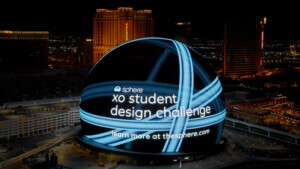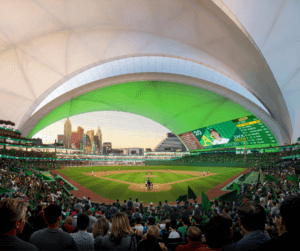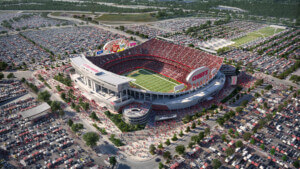As Las Vegas recovers from the Great Recession, city and business leaders are betting that the region’s future lies in a more diverse set of recreational offerings than the ones that made the city famous. Though many of the transformative projects are still in the planning or construction phases, the signs are clear: The boom-and-bust region is moving away from a strictly gambling-focused urbanism toward one more broadly defined by indiscriminate leisure, including sports, large-scale conventions, relaxation, and even traditional mixed-use urbanism.
Most spectacularly, city and business leaders triumphed in their quest to lure the Oakland Raiders to Sin City with a new $1.9 billion stadium designed by Kansas City, Missouri–based Manica Architecture. The stadium, to be built for the 2020 season, features a horseshoe-shaped seating arrangement that faces an operable building wall oriented toward the Strip. The complex will feature a celebration terrace containing a 120-foot tall cauldron honoring storied Raiders coach Al Davis, as well.
Adding to the sports frenzy, local architects YWS recently unveiled plans for a 30,000-square-foot Esports venue, Las Vegas’s first virtual sports facility. The complex will contain a multilevel arena, large-scale video wall, and a broadcast studio, all expected to open in early 2018.
The city is scrambling to prepare for the Raiders by embarking on $900 million in road and transit improvements, including a potential 1.14-mile monorail extension. The link would create a five-mile-long elevated train line connecting the stadium with 12 hotel and casino properties and the Las Vegas Convention Center. To boot, state agencies recently proposed a $12.5 billion plan for a new light rail system for the city.
The city is also looking to expand and upgrade its existing convention center by adding 600,000 square feet of exhibit space to the aging complex. The bet here is for Las Vegas to draw larger convention crowds, competing with cities like Orlando and Chicago (which are also expanding their convention centers). The new convention center is expected to draw an additional 610,000 visitors to the city, plus $810 million in revenue for good measure.
Closer to the forthcoming stadium, work has been underway to diversify the city at the street level as well. Recently completed streetscape improvements by planning firm Cooper Robertson, Marnell Companies, and !melk landscape architects for the Park—an eight-acre pedestrian plaza and park located between the New York-New York and Monte Carlo resorts—have brought a bit of big-city life to the Strip. Designers on the project reoriented retail spaces to face what was formerly an alley and demolished a temporary sales center to create a new pedestrian park. Donald Clinton, partner at Cooper Robertson, said, “We were tasked to come up with new dining and entertainment uses that could actually face the strip.” When asked, “How can we upgrade what we’re doing in front of these older casinos?” Clinton explained that the project sought to bring new tenants to the reprogrammed street who could benefit from being near foot traffic while also connecting to the new, !melk-designed park. The design features a variety of native trees and shrubs, swale areas, and large, sculptural shade structures that collect water. The park is flanked on several sides by plaza areas serviced directly by brewpubs and cafes.
The scheme was enriched by the speculative development of the Populous-designed T-Mobile Arena, an LED-clad, diamond-inspired structure that seats up to 19,000 and contains a slew of VIP zones, lounges, and nightclubs at the end of the new promenade. Clinton explained that the city’s new approaches to urbanism were “still evolving,” but one thing is clear: Las Vegas is quickly becoming more than a gambler’s paradise.










